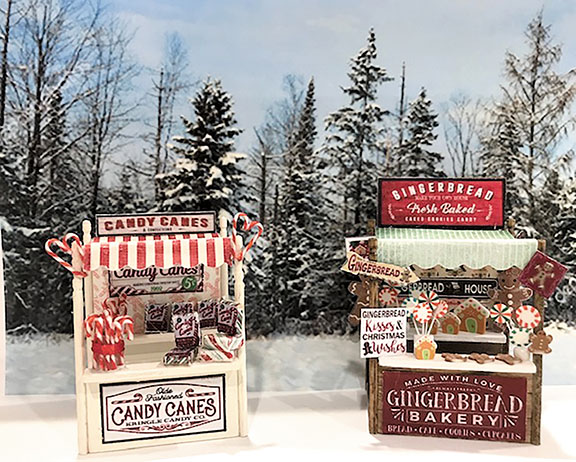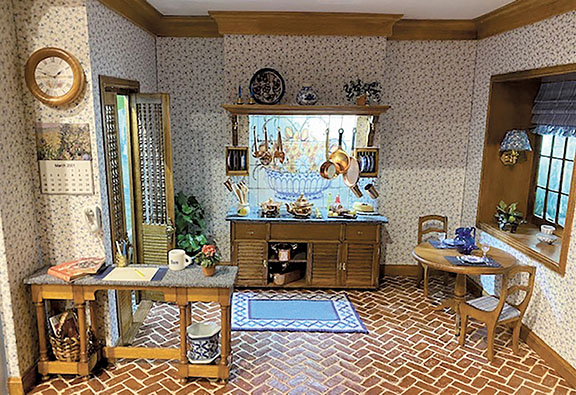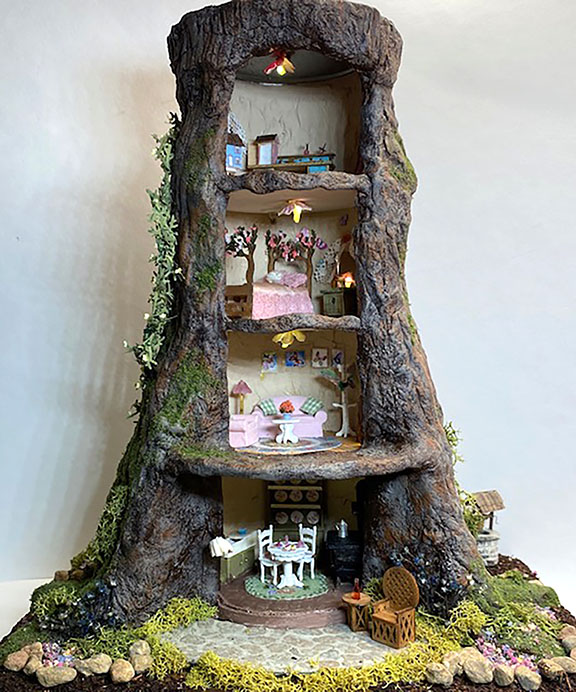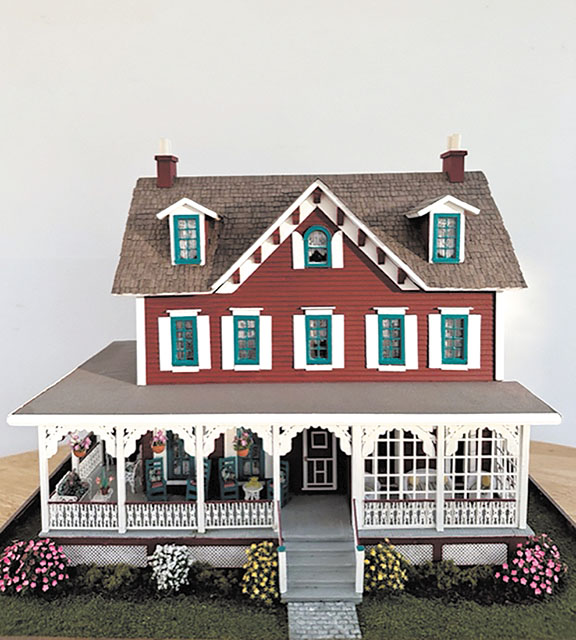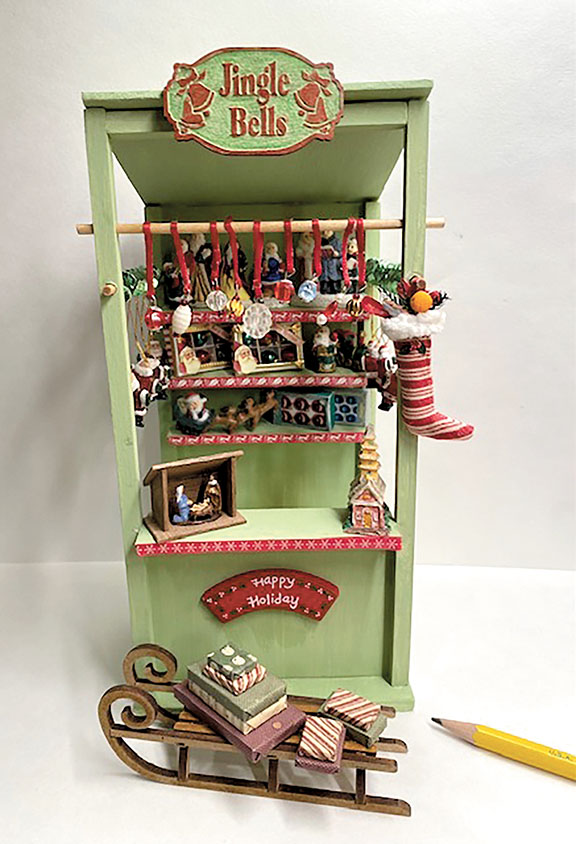By Helen Haughey
RED BANK – A cottage in Cotswold or a cabin in the Catskills, a café in Greece or a bookstore in Paris. While all you want for Christmas might not fit within your budget or even in a box, a scaled-down miniature version of the same might just be the most unique gift of all.
Miniature-making may be the most fascinating hobby most people have never heard of – and a special miniature can make a lovely present, whether you buy one or build it yourself. The word “miniature” conjures up visions of children and their toys, but there is so much more to it than dollhouses and it is certainly not just for children.
This year, the National Association of Miniature Enthusiasts (NAME) is celebrating its 50th year as the parent organization of miniature clubs in every state. Clubs meet so members can learn about miniatures, make their own “minis” and share them with others. The Jersey Inchkins Club, in existence for over 45 years, holds workshops and classes at monthly meetings at the Red Bank Public Library.
Miniaturists are people of all ages, in countries around the world, who create small things – from childhood homes to castles, holiday market stalls to exotic bazaars, the North Pole toy factory to space shuttles, the list is limitless. Almost anything found in real life can be scaled down to an inch or less: flowers and plants, food and beverages, pillows and rugs, paintings and curtains, furniture and kitchen appliances, picnic tables and barbecue grills. These tiny items are used to create scenes built inside boxes. And the encasing structure can be as unique as the scenes they contain – an antique breadbox or a glass case – and are decorated, furnished and accessorized to the minutest details.
One of the most famous miniatures in the world is Queen Mary’s dollhouse, built in the 1920s, and displayed in Windsor Castle, United Kingdom. It has running water, real china plates, readable books and replicas of famous paintings, done by some of the artists themselves. The wine bottles contain real wine and there are solid gold fixtures. Visitors to Windsor Castle may tour the dollhouse and see the gardens, the cars, the working bicycle. It has inspired miniature-loving folks for generations.
While it seems like the intricate work of professional artists, almost anyone can create miniature pieces with tools found in craft stores. Many hobbies require expensive equipment but miniaturists often use simple items at hand, like craft knives, scissors, glue, rulers and toothpicks. Most supplies used are wood, clay, scrap fabric and paper.
Skills used by miniaturists to make their scenes are as varied as the miniaturists themselves. Many use skills honed for years in their homes: painting, cutting out fabric, wallpapering, matching colors and gathering accessories to match a room. Others may bring skills like embroidery, sewing or needlepoint. Some have worked with wood, building life-sized furniture and use that knowledge to make small pieces. A few very important skills many miniaturists have are the ability to share, to teach and help one another.
The ideas for small-scale projects are limitless, whether you gift the miniature or build it for yourself. Those who want to walk down memory lane can build (or commission) a custom-made mini version of their own home. A miniature version of your house could include replicas of the furniture, family pictures on the wall, a doghouse, a cat tree and even Sunday dinner on the table. You could also build a “room where it happened,” a romantic restaurant scene where a proposal took place, a golden anniversary keepsake room or a baby’s room.
It is also possible to make in miniature what doesn’t exist in real life: a city dweller who craves a simpler life might build a cozy cabin in the woods. A pristine color-coordinated bedroom with everything neat and pretty might be the dream of a mom whose real house is full of toys and sporting equipment.
Many miniaturists make special scenes depicting a time in their lives as a three-dimensional memory box. These make great gifts for friends or family.
Often miniature scenes become part of holiday decorating. And one of the most popular holidays for miniatures is Christmas. Favorite items include Santa’s house with toys being made by elves in an attic supervised by him while Mrs. Claus makes cookies in her kitchen, or a decorated tree in a Victorian living room full of candles and fans and nosegays, or a toy store filled with handmade toys or a Christmas shop with lots of tiny ornaments and trimmings.
Miniaturists attend shows and sales across the country where they display their work, sell the miniatures they have made and admire the beauty of other very small worlds. At many of these shows experienced teachers run classes in the art of miniature making. There are exhibits of miniatures made by local mini makers and prizes offered for the Best in Show.
The recent pandemic kept many people isolated at home looking for something to do. Many discovered miniatures in the form of easy-to-do, everything-included kits that appeared in craft stores. People who never thought of themselves as “crafty” produced a pretty bedroom, a candy story, a bakery, a bookstore or a flower shop.
“Life is messy” is a common expression, perhaps that is why creating one’s own small world is so appealing. Making miniatures is both a fun, creative outlet and an art form.
If you’re still looking for the perfect gift, remember, good things come in small packages!
Helen Haughey is president of the Jersey Inchkins Club which welcomes new members to meetings held at 1 p.m. the third Thursday of every month on the lower level of the Red Bank Public Library. For more information visit redbanklibrary.org.
The article originally appeared in the December 1 – 7, 2022 print edition of The Two River Times.


